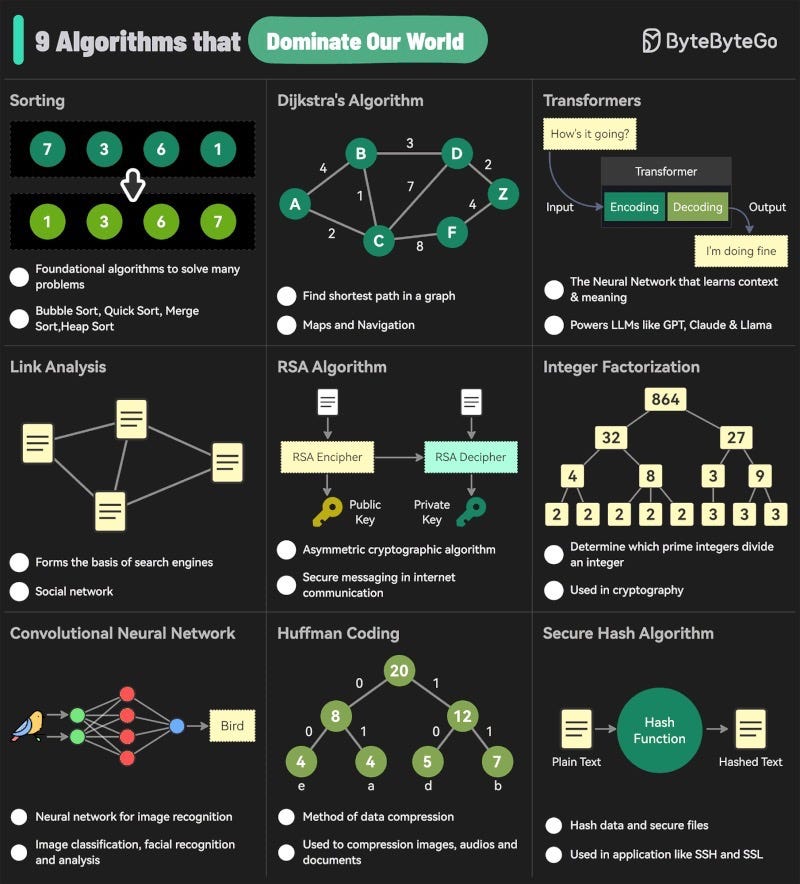These algorithms are the invisible engines powering our digital world. From secure communication to groundbreaking AI applications, they influence nearly every aspect of modern technology.
Here’s a deep dive into how they work and where they’re applied:
1. Sorting Algorithms
Sorting is fundamental in organizing and retrieving data efficiently.
Key Examples: QuickSort, MergeSort, Bubble Sort, and Heap Sort.
Applications:
Search engines organize massive amounts of data to deliver relevant results.
E-commerce sites like Amazon sort products based on price, ratings, or relevance.
Databases optimize storage and retrieval of information using sorting techniques.
2. Dijkstra’s Algorithm
A pathfinding algorithm that finds the shortest route between nodes in a graph.
Applications:
Google Maps and GPS systems: Calculate the fastest route for navigation.
Network routing protocols: Optimize data flow in communication networks (e.g., OSPF).
Transportation systems: Used in railways and flight scheduling.
Game development: To calculate paths for NPCs (non-player characters).
3. Link Analysis
Analyzes the connections between nodes in a network, forming the basis of ranking systems.
Key Example: Google’s PageRank algorithm.
Applications:
Search engines: Rank websites based on relevance and authority.
Social media platforms: Identify influential users (e.g., X, Instagram and facebook “Who to Follow” suggestions).
Fraud detection: Spot suspicious patterns in financial networks.
Scientific research: Determine the most cited papers in academic journals.
4. RSA Algorithm
A public-key encryption algorithm critical for securing online data.
Applications:
Online banking and payments: Encrypt sensitive information like credit card numbers.
Messaging apps: Secure communication (e.g., WhatsApp).
Digital signatures: Verify the authenticity of documents and emails.
VPNs: Encrypt internet traffic to protect user privacy.
5. Integer Factorization
A mathematical problem underlying the security of RSA encryption. It ensures encrypted messages are difficult to break.
Applications:
Cryptography: Prevents hackers from decrypting sensitive information.
Blockchain technology: Protects digital wallets and transactions.
Quantum computing research: Theoretical algorithms like Shor’s algorithm aim to break factorization-based cryptography.
6. Convolutional Neural Networks (CNNs)
A type of deep learning model designed to process visual data.
Applications:
Facial recognition: Unlock smartphones and secure premises.
Self-driving cars: Detect and classify objects like pedestrians, signs, and vehicles.
Medical imaging: Diagnose diseases from X-rays, MRIs, and CT scans.
Content recommendation: Suggest visually similar items (e.g., Pinterest or e-commerce platforms).
Gaming: Enhance virtual reality (VR) and augmented reality (AR) experiences.
7. Huffman Coding
A compression algorithm that reduces file sizes by assigning shorter codes to more frequent data.
Applications:
Multimedia compression: Reduces audio (MP3) and image (JPEG) file sizes.
File archiving: Compresses files into ZIP formats.
Text messaging: Reduces the size of transmitted SMS data.
Streaming services: Ensures fast delivery of video and audio (e.g., Netflix, Spotify).
8. Secure Hash Algorithm (SHA)
A cryptographic hash function that ensures data integrity by producing a fixed-size hash value from input data.
Applications:
Blockchain technology: Validates transactions and prevents tampering.
Password storage: Protects user credentials in databases.
Digital certificates: Ensures authenticity in secure websites (HTTPS).
File verification: Confirms file integrity during downloads (e.g., checksums).
9. Transformers
Transformers revolutionized natural language processing (NLP) by introducing attention mechanisms that handle sequential data.
Applications:
AI language models: Power chatbots (e.g., GPT, Bard) and voice assistants (e.g., Alexa, Siri).
Translation tools: Enable real-time language translation (e.g., Google Translate).
Content creation: Automate article writing, script generation, and more.
Healthcare: Summarize patient data or assist in medical research.
Customer support: Automate responses and improve user experiences.
From simplifying tasks like online shopping to enabling futuristic innovations like self-driving cars, these algorithms continue to redefine what’s possible in our tech-driven world.
💡 Which of these algorithms impacts your daily life the most?
Thanks for reading.



